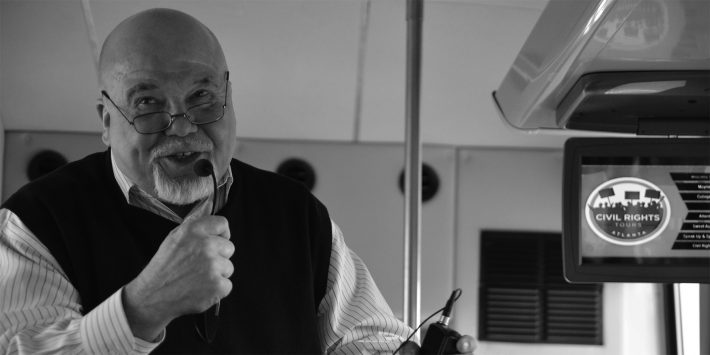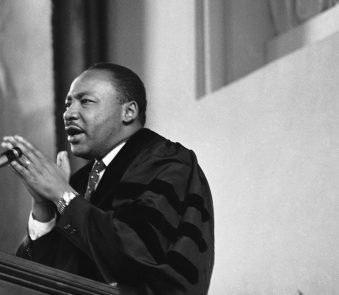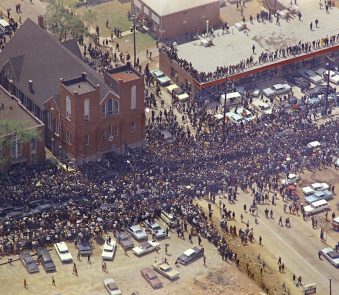MLK’s Driver Leads Tour Through Atlanta Civil Rights History

 In My List
In My List
This story was published in February 2016.
Fifty years ago, a 19-year-old Tom Houck stood in front of the Southern Christian Leadership Committee (SCLC) headquarters on Auburn Avenue and waited for a ride to the Freedom House where he was staying.
As he waited, Rev. Dr. Martin Luther King Jr. happened to be driving on Auburn Avenue. King saw Houck, recognized him from his work in Birmingham, and invited him to his house for lunch with his family. At the lunch, Coretta Scott King, King’s wife, asked if he had a license and if he could take their children to school the next morning. Houck didn’t know Atlanta well but agreed to take the children.
“I had GPS in my mind back then and I took them to school. That’s when I became the accidental driver.”
Driving the kids to school turned into a nine-month gig as MLK’s personal driver and aide. It was during this time that he got to know King and pick up on his personality quirks – like his smoking habit and interest in music on WAOK radio. While he was driving the King family he continued to work for the SCLC. The experience gave young Houck – who had not finished high school – an unparalleled education in movement work.
Though he was young and surrounded by the civil rights movement’s most prominent leaders, Houck was no stranger to the civil rights activism. As a high school student in Jacksonville, he became a student organizer – bringing his classmates together around issues of segregation, Jim Crow and public accommodation laws. He was later expelled from high school for his participation in the march from Selma to Montgomery but continued civil rights work throughout the South, journeying through the Florida panhandle, Alabama and Mississippi. It was in Birmingham that he began working with the SCLC and where he first met King.
After King was assassinated in 1968, Houck continued his activism around the country, working in various political campaigns, voter registration drives and anti-war movements.
Later he would pursue another interest – journalism – working in radio, print and television in Atlanta until he retired in the early 2000s.
For Houck, doing a tour of the city might seem like a natural fit, but he says that it was friends who actually encouraged him.
“I would take my friends around and everybody was saying ‘Tom, you should be doing a tour.’ So I looked into it and there weren’t really any good ones out there. So I decided I would put together a tour.”

He did some research and interviewed civil rights leaders he knew from the movement, including Julian Bond, John Lewis and Andrew Young – all of whom make appearances via video monitors mounted on the bus’ ceiling. He began his first public tour in April of 2015.
On a recent Saturday morning, the white 30-seat coach tour bus met its passengers in front of the Martin Luther King Jr. gravesite – one of Atlanta’s most popular and recognizable landmarks. The tour’s first stop was on Auburn Avenue, which once enjoyed the distinction of being the “richest Negro street in the world” for its vibrant business community. During the civil rights movement, the same street held the headquarters for some of the movement’s most noted organizations, including the SCLC, as well as nightclubs and restaurants that were popular with the movement crowd.
However, like many of the sites on the tour, the once-vibrant street has struggled in recent decades. Many of the buildings that once thrived in the area now sit vacant and several efforts to revitalize the area have not been successful. Houck acknowledged that many of the landmarks simply no longer exist.
“You will see today a lot of sad history of Atlanta,” he announced to the tour bus. “It needs to be revitalized and it needs to be really updated because we’re not sharing with the rest of the world [the] joys and the riches of our civil rights movement in Atlanta.”
The tour makes more stops – among them the now shuttered Morris Brown College, the King family home in Vine City and South-View Cemetery. Each stop holds a short story or memory that stresses the civil rights movement’s more human side. As the bus drove by an old post office, Houck recited the old zip code “30314” and launched into a story about picking up mail.
According to Houck, Dr.King would sometimes get his own mail and the excited postal workers would stop what they were doing to greet him.
“King didn’t have big brigades or people behind him. He didn’t have security. It was usually just him and me together,” he recalled. “I was his security and I guess you could say he was my security!” he said as the tour group looked out the windows.
To add some sound to the tour Houck enlisted the services of a young law student, Daryl Thomas, to sing popular freedom songs during the ride. Thomas said his experience as the tour bus cantor has been particularly meaningful to him.
“I graduated from an HBCU and a lot of the information Tom gives us, we didn’t learn about in school. A lot of these landmarks are right around the corner from our institution and we never learned about them,” Thomas said.
Tourist Gabrielle Haney, who grew up in the Bronx, appreciated the general overview of the civil rights movement: “I really didn’t know the true depth of the history and how present Atlanta is in that history.”
But what resonated with Haney the most was King’s human side.
“A lot of people look up to him as saintly, but he was very much one of us. He worked briefly in a mattress factory, lived in Vine City, played pool and wanted to be connected to the people. That just makes me realize how each and every one [of us] may not be a saint, but we can be as Martin Luther King [Jr.] was to make a difference as much as he has.”
You can visit the tour’s website for more information.



